Fly fishing with strike indicators
Fly fishing with strike indicators for trout and steelhead can sometimes be a point of contention among anglers as it can be viewed as a departure from ‘traditional’ fly fishing. Regardless, it’s a style of fishing that is productive and likely won’t be going away any time soon.
What is a strike indicator? Well, to be frank, it’s a glorified bobber. They are constructed of a number of different materials such as plastic, balsa, or synthetic ‘hair’/ yarn. Strike indicators act (as the name implies) as an implement used in detecting when a fish takes your fly (among other benefits).
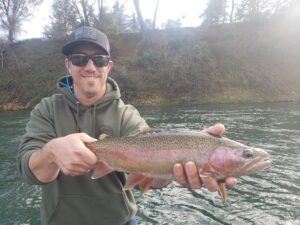
Sacramento river trout caught using a strike indicator on a drift boat trip.
Why should I be fly fishing with strike indicators?
It’s effective…it really is. Using wet flies, nymphs, under an indicator gives the angler an ability to suspend their presentation near the bottom (or anywhere in the water column really) and also increase the distance an effective ‘drift’ can be fished. Add a drift boat into the equation and extremely long drifts with maximum time in the strike zone become possible.
Another advantage to this technique is it’s very conducive to teaching new anglers. Less casting, longer drifts, more grabs are all things we want to happen to get new anglers engaged. Don’t get me wrong, this isn’t just for inexperienced anglers! Skilled flyfishers who hone their indicator game are very successful on the water and it gives you another tool in your toolbelt to draw from.
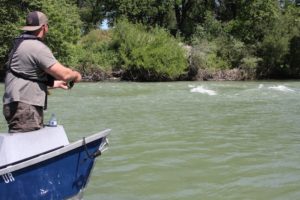
Drifting an indicator rig from a drift boat on the Lower Sacramento River.
How do I rig up for fly fishing with strike indicators?
With a floating flyline connect your leader material to the butt section. DO NOT use tapered leaders for an indicator specific setup. Sometimes I will use a colored length of line that rates somewhere between the butt section and leader material in strength. This acts as a sighter showing which way the leader is going in relation to the indicator. That can become important in swirly water or when trying to determine which way to mend one’s line while drifting. It also acts as a great location to rig a sliding indicator such as a Jaydacator. Check out Jaydacators here.
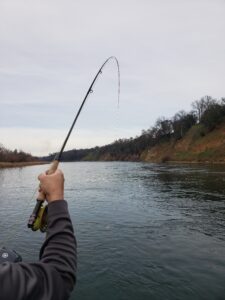
The reward of using a strike indicator on bigger water. The Jaydacator is in use here.
I’ve found a straight fluorocarbon leader is the most effective for me, it’s strong, sinks well, and is less prone to planing-out in the current. From your leader attach tippet and your flies (double nymph rigging is pretty common).
Exactly where you place your indicator, and what type of indicator you use will depend on what type of water you are fishing. Smaller pieces of water requiring less weight and less leader length typically call for small indicators with less surface area and buoyancy. On larger waters, such as the Lower Sacramento River, where long leaders and lots of weight are used, it’s more common to see the larger sliding indicators with maximum buoyancy. The downside with this setup is it can be cumbersome to cast and has a tendancy to be less than forgiving when it comes to tangles.
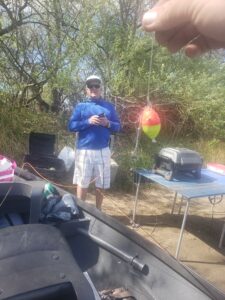
Tangles happen….
How do I fish with a strike indicator rig?
The most common use for an indicator setup is to achieve a ‘dead-drift’ where the goal is to keep your flies drifting naturally at current speed with no ‘drag’ or influence from the mainline on your presentation. There are several ways to do this depending, again, on the type of water you are fishing.
On smaller waters where you may be wade fishing, the casts might be constrained and the fish holding in small pockets. Keeping the line mostly off the water and casting directly upstream might be the ticket. Another way might be to cast upstream and across, allowing your presentation to sink before getting to the targeted holding water, and then the angler would mend the line to keep the presentation in the strike zone.
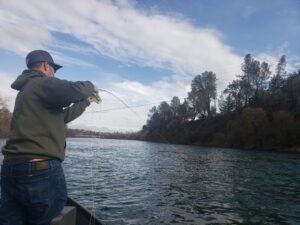
Using strike indicators is a great way to get hookups!
When using an indicator setup on a larger river like the Lower Sacramento River, a very effective technique is to use a drift boat. The anglers cast into the likely holding water and the oarsman follows or parallels the indicators as the rigs float downstream. The anglers frequently mend the lines to achieve the longest dead-drift possible. This is a great way to cover lots of big water and maximize your time in the strike zone. You can find video here.
To learn more in a hands-on environment, hire one of our experienced fly fishing guides for a day of drift boat fishing or walk and wade fishing.
Click here for more info on Northern CA fishing trips.
River Pursuit Guide Service offers fly fishing trips in Northern CA year ’round for trout and steelhead.
Another Sacramento River fly fishing video can be found here.